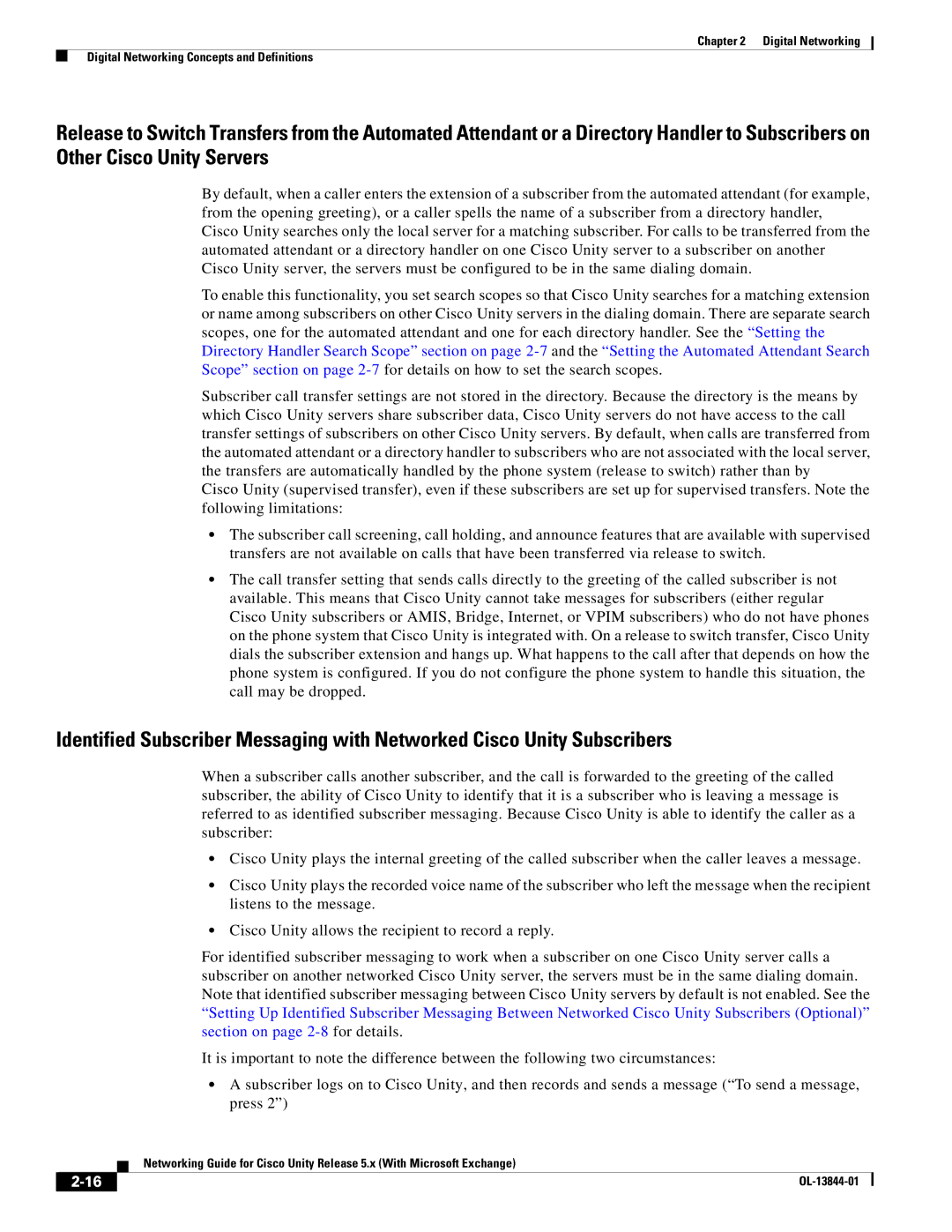
Chapter 2 Digital Networking
Digital Networking Concepts and Definitions
Release to Switch Transfers from the Automated Attendant or a Directory Handler to Subscribers on Other Cisco Unity Servers
By default, when a caller enters the extension of a subscriber from the automated attendant (for example, from the opening greeting), or a caller spells the name of a subscriber from a directory handler, Cisco Unity searches only the local server for a matching subscriber. For calls to be transferred from the automated attendant or a directory handler on one Cisco Unity server to a subscriber on another Cisco Unity server, the servers must be configured to be in the same dialing domain.
To enable this functionality, you set search scopes so that Cisco Unity searches for a matching extension or name among subscribers on other Cisco Unity servers in the dialing domain. There are separate search scopes, one for the automated attendant and one for each directory handler. See the “Setting the Directory Handler Search Scope” section on page
Subscriber call transfer settings are not stored in the directory. Because the directory is the means by which Cisco Unity servers share subscriber data, Cisco Unity servers do not have access to the call transfer settings of subscribers on other Cisco Unity servers. By default, when calls are transferred from the automated attendant or a directory handler to subscribers who are not associated with the local server, the transfers are automatically handled by the phone system (release to switch) rather than by
Cisco Unity (supervised transfer), even if these subscribers are set up for supervised transfers. Note the following limitations:
•The subscriber call screening, call holding, and announce features that are available with supervised transfers are not available on calls that have been transferred via release to switch.
•The call transfer setting that sends calls directly to the greeting of the called subscriber is not available. This means that Cisco Unity cannot take messages for subscribers (either regular Cisco Unity subscribers or AMIS, Bridge, Internet, or VPIM subscribers) who do not have phones on the phone system that Cisco Unity is integrated with. On a release to switch transfer, Cisco Unity dials the subscriber extension and hangs up. What happens to the call after that depends on how the phone system is configured. If you do not configure the phone system to handle this situation, the call may be dropped.
Identified Subscriber Messaging with Networked Cisco Unity Subscribers
When a subscriber calls another subscriber, and the call is forwarded to the greeting of the called subscriber, the ability of Cisco Unity to identify that it is a subscriber who is leaving a message is referred to as identified subscriber messaging. Because Cisco Unity is able to identify the caller as a subscriber:
•Cisco Unity plays the internal greeting of the called subscriber when the caller leaves a message.
•Cisco Unity plays the recorded voice name of the subscriber who left the message when the recipient listens to the message.
•Cisco Unity allows the recipient to record a reply.
For identified subscriber messaging to work when a subscriber on one Cisco Unity server calls a subscriber on another networked Cisco Unity server, the servers must be in the same dialing domain. Note that identified subscriber messaging between Cisco Unity servers by default is not enabled. See the “Setting Up Identified Subscriber Messaging Between Networked Cisco Unity Subscribers (Optional)” section on page
It is important to note the difference between the following two circumstances:
•A subscriber logs on to Cisco Unity, and then records and sends a message (“To send a message, press 2”)
| Networking Guide for Cisco Unity Release 5.x (With Microsoft Exchange) |
|
